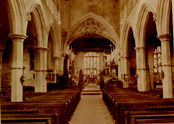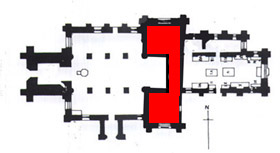St Mary's Bottesford Phase III Perpendicular Style
Gothic Perpendicular Style 1350-1430
By Bob Sparham
The further development of the south aisle which had began c1345 was interrupted by a catastrophic event. In 1348 Bottesford like the rest of England fell victim to a plague which was called the Black Death. A plague which had been brought to England from the East, by shipboard brown rats. An average of 25% of the English population died of this illness, which was the catalyst for major social and cultural changes in society. The contrast between the North and South aisles of the Church gives an interesting example of the architectural changes that were, in part caused by the pestilence.
An important effect of the Black Death was to stimulate even greater efforts in Church building . The plague was often understood to have been caused by a Judgement of God on the sinfulness of the people. A negative judgement that could in future be best avoided by greater piety. Another factor which influenced the transformation of Decorated architecture into Perpendicular was the start of the Hundred Years War against France and the atmosphere following the victory at the Battle of Crécy in 1346 . The reaction to the Black Death meant that there would be more Church building, the reaction to the French war meant that it would in an English rather than a French style. As you can see by looking at the windows of the North aisle the Perpendicular style is less dependant on the pointed arch and tends to be squarer and squatter in form.
Two of the de Roos family died in the Hundred Years war, John Lord Roos and his brother William were killed following Henry V in 1421 at the battle of Bauge. John was buried at Croxton Abbey together with his father William Baron Roos and their tombs were moved to here to Bottesford Church after the Dissolution. They can be seen (together with some really interesting Graffiti) on the North and South sides of the sanctuary in the Chancel.
Devotion to the Saints was a very important feature of medieval church life. In medieval theology the church was divided into three sections. The Church Militant which was made up of the people alive on earth, The Church Suffering, the souls of the dead in purgatory, and the The Church Triumphant , the saints in heaven. All of these groups were interdependent and they are reflected in the architecture of the church.
On either side of the Chancel arch are the North and South Transepts. These areas were special screened chapels which were known as Chantries. The belief was that when someone died, they passed from The Church Militant into The Church Suffering, where they were sentenced a spell in purgatory whose length varied according to the sins they had committed. In the Chantry, priests intervened with prayers and masses to the saints, of The Church Triumphant to shorten the sufferings of the dead who had funded the Chapel. St Mary’s like all medieval churches had a chapel and Chantry dedicated to Our Lady. ours was in the South Trancept whereas the North had a Chantry dedicated to St Peter.
There were two great contrasts between the medieval and the modern Church. Firstly the Church was not a unified building with an uninterrupted vista from the Nave through to the Chancel, rather its interior was more like a series of self contained screened rooms, than a continuous space. The second contrast is related to the colours of the interior. As you look around the Church today, the predominant colour scheme you see, is a subdued palette of natural stone and wood of greys and browns. However the medieval church would have been a riot of colour. All of the stonework would have been painted including the columns, capitals and mouldings. The walls and screens were covered with murals of saints, or scriptural subjects, and the woodwork gleamed with colour and gilding.
Here in St Mary’s, fragments of medieval colour have survived particularly over the Chancel Arch, where you can see the remains of a ‘Doom’ painting. As we have seen the most important image in the church was the Rood, the large wooden carved crucifix with the carved figures of the Virgin Mary on the right side and St John the Evangelist on the right. This 3D tableau was framed by the Doom or Last Judgement painting. For the people of the Middle Ages sin was an ever present reality and the Doom was placed in the most prominent position in the Church, so that all those entering the church were constantly reminded of the rewards and punishments of the Day of Judgement. More than a hundred Doom paintings have survived in different parts of the country and all more or less follow a standard scheme. Generally this consisted of a figure of Christ in Majesty pronouncing on the destiny of the dead, who rise from their graves to join the living. Below on the left angels conduct the righteous to Paradise and on the other side demons drive lost souls into the mouth of Hell.
In our Doom painting, Christ the main subject of the picture has been lost from the decayed central area. However it is still possible to see his supporting angels blowing trumpets and two other saints wearing halos slightly lower down and nearer the centre. One of these on the North side is the Virgin Mary. Also on the North side there are symbols of the crucifixion, a smaller figure caring a bundle of birch rods and a hammer, with a pair of pincers on the opposite side of the picture.
Lower down the cross-belted figure of St Andrew stands ushering the righteous into heaven, below a nude figure pleads for mercy, whist below him a devil prods sinners into hell.
As you look at the painting you can see a central pyramid with its point to the roof , which is of different texture to the rest of the wall. This triangle is the line of the original Decorated period roof. The other sections together with the line of windows along the top of both sides of the Nave, the Clerestory, both date from the period between 1450-1500, which is also when the painting was made. The Clerestory windows were originally stained glass, and like most other Clerestories it was built to provide illumination for the Rood and Doom. One theory to explain this phase of the building links it to the restoration to Belvoir Castle in 1485 of the de Roos family.













No Comments
Add a comment about this page